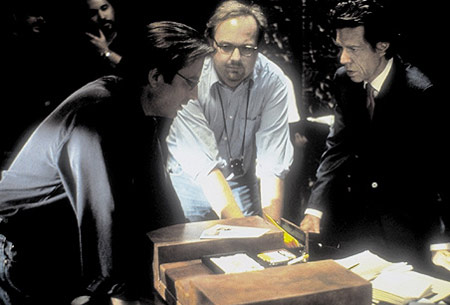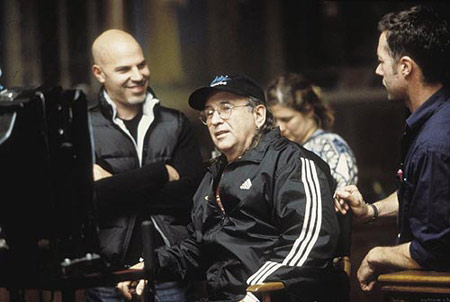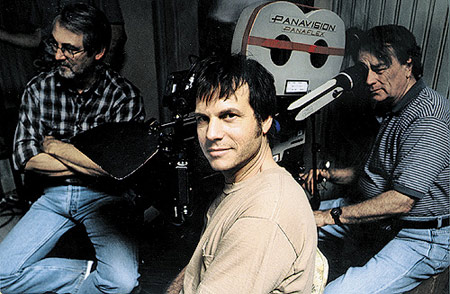By Tarvis Watson
Acquiring distribution is not the last step on the path to getting your independent film into theaters. The act of distribution itself is an important, make-or-break process that encompasses everything from how a picture will open (in which cities and on how many screens) to the film's trailers, posters, ad campaigns and the like. What is the role of the director in this process? What should his or her role be? Several directors of recent independent films offered their thoughts and advice on the subject. All agreed that communication with the distributor as early as possible is key, but they differed on how seriously they thought their ideas were truly considered, and they offered a variety of ideas for reaching audiences beyond the mainstream advertising process.
The bottom line: It's difficult for directors to get their marketing ideas considered, much less heeded, but not impossible. Play ball with the executives. If you show a willingness to listen to the distributors and let the marketing people do their jobs, and then present your ideas in a diplomatic way, you have a shot at being heard and at shaping your film's marketing campaign — at least a little.

"Sometimes when I'm shooting or cutting a scene," said George Hickenlooper, "I'll earmark it and think, 'this would be great in the trailer.' But ultimately I find that most distributors just don't want to hear what the director has to say. There's definitely a huge wall there. My sense is that they see us perhaps as out-of-control, artistic types who are not sensitive to the financial needs of the distribution apparatus. I think that's wrong. Some of my earlier films I distributed virtually myself, and I'm very keen about what works and what doesn't. I also find that a lot of marketing departments work by committee — there's never one really smart idea that's able to blossom because you've got so many different opinions you're trying to cater to."
Moreover, Hickenlooper said that in his experience, even when a distributor does ask him for his ideas early in the process, they are rarely heeded. On The Man From Elysian Fields, he said, "in terms of designing the one-sheet, they politely welcomed my comments, but overall didn't use any of my ideas. Unless you're a top Hollywood director, that's pretty standard." In fact, distributor Samuel Goldwyn was most interested in Hickenlooper's sense of how to use the cast, particularly Mick Jagger, to promote the picture.
Ironically, Jagger was not used as much as anyone would have liked. The film's poster design was complicated by an unfortunate problem that many other directors have run into as well. "There were five above-the-title names," explained Hickenlooper, "and all of them contractually had visual parity on the artwork. So we were either going to have a cluttered Irwin Allen-like one-sheet with five faces, or we weren't going to be able to use anybody's face." This made for quite a challenge, and in the end the marketing department went with no faces, opting to use an image of a man tying his tie with a woman's leg in the background. "I think it worked more or less," said the director, "but it wasn't anything to write home about. It killed us to have Mick Jagger and Andy Garcia as the stars but not use their faces on the one-sheet."
Hickenlooper was quick to add, however, that while he had little involvement in the conception of the poster, once it was finalized his suggestions for further alterations were graciously considered, even leading to a few changes. "The key for directors is really to build a personal relationship with the marketing department as early on in the process as possible."
The release strategy was "to open it in the city that we thought the critics would be kindest to the picture" so their positive blurbs could be used in subsequent ads. The picture opened first exclusively in Los Angeles, recalled Hickenlooper, because "we knew the L.A. press liked it more than the N.Y. press. But we got great reviews in New York, to our surprise."
Tim Story admitted, "I was lucky. I was listened to. The studio allowed me to present the film to the best of my ability." One of Story's prime concerns regarding the marketing of Barbershop, a hit for MGM last fall, was that the film's dramatic "heart" come through. "We always knew it was first and foremost a comedy," he said, "but there was a heart that we wanted to relay. We didn't want people to write off the film as just another black comedy. We wanted them to know there was a little more going on."
Story and his producers, including George Tillman, Jr., accomplished this in a very specific way with the film's one-sheet poster. "The original design — the colors of the poster, the sizes of the characters — said 'comedy' and not much more. I was very adamant that it relay more depth." Story suggested to the studio that instead of showing comedic close-ups of the actors which obscured the poster's background, they make the barbershop design in the background much more visible — more of a character itself. This subtle change would suggest more of a story (and a greater accuracy) to viewers than would comedic faces alone. When Story's changes tested well, MGM stuck with them.
In the case of Barbershop's trailer, the opposite occurred. MGM didn't think the first trailer cut by the filmmakers was funny enough, recalled Tillman, "but we felt the audience would love it." Tillman and Story compromised: a new trailer would be cut, but in the meantime the studio would go out with the first one. It played through the roof and the second trailer was never made.
"MGM promoted this film better than any black film I've ever seen," said Story, but "for independent or smaller niche movies, you've got to look outside what the studio will do. Anything we could do, we did it." This included taking the film to a hair industry show in Atlanta and to the National Association of Black Journalists convention in Milwaukee. "Those were avenues MGM didn't know about at the time," said Tillman, who already had experience with similar marketing ideas on his own directorial outings Soul Food and Men of Honor. "They were open to listening because they felt that we were very tuned to the audience we were making the movie for."
On Soul Food, Tillman set up many free screenings in controlled environments to start positive word of mouth. The same strategy paid off on Barbershop; for example, the filmmakers took it to their alma maters. "You think that you're just giving the movie away," said Tillman, "but after awhile you start getting a sense of where you want to go with the marketing. It shows you who your audience is."
Story added, "The idea was that even if people see it for free, they're going to want their mom and dad to see it. It worked. I can't tell you how many people told us, 'I saw the movie and then I went back with my sister, my little brother.'"
Testing Barbershop for white audiences also paid off, leading MGM to open the film on several hundred more screens than planned. "We thought our themes were very universal," said Tillman, "and we let them know the film had potential to cross over."
Story and Tillman both stressed reaching out to the studio or distributor early in the filmmaking process. "Do it before you shoot," said Story, "and also during shooting. Make sure you have an open dialogue and make sure you and the studio are on the same page. Every step of the way [on Barbershop] there was very good communication about what we wanted this movie to be."

No marketing strategist could have foreseen or planned the phenomenal success of My Big Fat Greek Wedding, a $5 million picture that has taken in well over $200 million domestically. At a certain point last summer, the film's success itself became a media story and marketing hook, feeding the box office even more. But a careful, nurturing release plan was key to getting things started, and it boiled down to aggressively pursuing the film's core ethnic audience prior to opening weekend. This was done by carefully choosing cities and theaters in which to open the film and, as with Barbershop, having many free screenings beforehand to start word-of-mouth.
"It was very different from a typical indie, arthouse film," said Bob Berney, who at the time was Senior Vice President of Marketing and Distribution at IFC Films, which handled distribution for Greek Wedding's U.S. release. "It was pushed as an audience response film. We did a lot of promotional screenings, as opposed to director-driven interviews or reviews. It was really a word-of-mouth strategy. We would get church groups or Greek groups to band together and buy out a first show, like at 10 a.m. on Friday. Not only did that help the actual initial grosses of the film, but we had instant ambassadors for the film coming out of the screening. This made an impact on the public and the exhibitors."
"Bob had a commercial vehicle on his hands, and he played it beautifully," said director Joel Zwick. "Rather than open it in just one or two theaters in Los Angeles and New York, they targeted cities with strong Greek-American or other ethnic American centers, like Chicago, Detroit, and Dallas" and opened it on more than 100 screens.
"Nia [Vardalos, the film's star and writer], Gary [Goetzman, producer], Paula Silver, who was very instrumental in the marketing, and I would schlep about the theaters of Los Angeles and get a sense of how people were reacting to the film," added executive producer Paul Brooks. Brooks is also President of Gold Circle Films which put up fifty percent of the funding for the production. "It's on the street that you get the real sense of people's reactions to the film.
"We knew we just needed to nurture and support the film and to enable word of mouth to growth," he said. "We also opened at a time when we were able to get a few weeks of getting that platform in. We took the position that whenever a blockbuster came in, we knew we'd get smashed, but we figured we could bounce back because we so believed in the inherent word-of-mouth button that the film had."
The opening weekend's high per-screen average, continued Zwick, confirmed for the studio what their test screenings had told them, "that they essentially had a commercial movie with no stars, and that they were going to have to market it differently — keep the growth slow. They would rather have big audiences in less theaters than vice versa. And that was a very smart choice, because comedies need a sense of community to really work. Put a lot of people in the theater and laughter can become infectious. Put in seven people, and you don't get the same feeling."
In voicing his marketing ideas, Zwick found, like other directors, that he was "just a voice in the wilderness." While he did not have much input into the release strategy, "I was not cut out of it. But I thought their strategy was great, brilliant. I mostly encouraged the continuation of it."
Zwick likened the issue of directors making suggestions to the marketing people to that of crew members making suggestions to directors on set. "It's very much like when I'm directing a movie," he said. "I have a job to do, and if people input me the wrong way, or at the wrong time, some very good ideas can go by the wayside. It's about when to talk to me, when to suggest it." Similarly, he said that distributors "don't have an hour's time every day for Joel Zwick, but they do have five or ten minutes for me to call and say how's it going, how many theaters, and so on. There was very little I disagreed with, obviously, because of the success, but when there was, I would put in my two cents.
"Unless you're a top A-list director who's probably also producing," he continued, "you have no power base. The only way you can get into areas that are not contractually protected by the DGA is by just basically being a nice person and playing it right. Making demands to promoters or distributors is certainly not going to get the job done. It will cut you out of the process."
Berney agreed, and said that personalities of all those involved are important: "I think distributors need to listen to the directors' input, and at the same time directors have to be open to looking at different ideas. It could be they're too focused on a certain vision, and they have to see, from a pure marketing advantage, other options.
"I think distributors generally have a bad reputation as not being inclusive, particularly at the bigger studios," he added. "My experience has been almost one hundred percent positive in trying to include directors in every aspect of the release, going back to Chris Nolan and Todd Solondz. Todd knew every theater in the country. Chris Nolan and his brother had done a website for Memento already and had ideas in terms of how it should be marketed with the website. It's personalities and how you work together."
Berney is known in the independent film world for his expert knowledge of particular exhibitors (he is himself a former exhibitor) and his fine instincts for individual films. In his current position as President of Newmarket Films, for example, he devised a release strategy for the HBO/Newmarket co-release Real Women Have Curves, directed by Patricia Cardoso, that was quite different from Greek Wedding. Free community screenings for female and Latino audiences played a part, but the release pattern itself varied from city to city. "Real Women was somewhat more of a traditional arthouse film," explained Berney. "It was platform released and review-driven. And the discovery of a new director was part of the marketing." In Los Angeles, however, the film received more of a mainstream-style release because of the city's large Latino population, opening in 30 theaters — as opposed to just two in New York. "We tried to mix it up," Berney said. The result? "Real Women started small but held in there strong every week."

One of the most unusual and eye-catching elements of Frailty's advertising campaign last spring were the endorsements by James Cameron, Sam Raimi and Stephen King which appeared in the film's print ads. Bill Paxton, making his feature directorial debut, came up with the idea after it appeared his psychological horror picture might fall victim to unfortunate timing. When the film first was screened for critics in November 2001, Paxton realized from their reactions that they would "dismiss it as just a genre piece. The press wasn't watching it very objectively. Because of the climate of the country at the time, they couldn't see the picture for what it was.
"I thought, 'I can't let my baby go out like this.' Jim Cameron and Sam Raimi had been very supportive, and had seen the picture early on, so I called them and said, 'Would it be too much to ask if you could support the picture with a quote?' They said, 'Not at all, we think this is a quality piece of work and we're glad to do it.' Then I thought, 'Well, the master of horror and suspense is Stephen King.' " Paxton called King's assistant cold and made arrangements for the author to see the film. "He wrote me back a couple of weeks later with a nice quote. I wasn't trying to preempt the critics but I need some support when the film came out." As it turned out, by the time Frailty was released in April, the tide had turned. "Enough time had gone by and suddenly it seemed like the critics were judging the film for its own merit." Still, the quotes made for a striking print ad. Paxton said that his distributor, Lions Gate, was supportive of the idea but left its execution entirely up to him.
Another headache was the one-sheet. Like Hickenlooper, Paxton had to deal with the problem of equal representation of his principal cast on the poster. "It really kills what you can do with the graphics," he said. In this case, however, since Paxton himself was one of the principals, he deleted himself from the poster and went with an image of Matthew McConaughey's face in the foreground and an ominous image of a barn in the background. "Lions Gate was very cool with that."
Indeed, Lions Gate was generally quite accepting of Paxton's ideas, but the process wasn't always easy. When Frailty's teaser played well early on, Lions Gate balked at producing a full trailer. Paxton and producer David Kirschner went ahead anyway, using leftover budget money to hire an outside company to cut one. "It turned out so well that Lions Gate decided to go forward with it," recalled Paxton.
"I was very pleased with Lions Gate," he continued. "It can be frustrating for a director, but you have to create your relationships early on with the marketing side, and be diplomatic enough not to create an adventure."